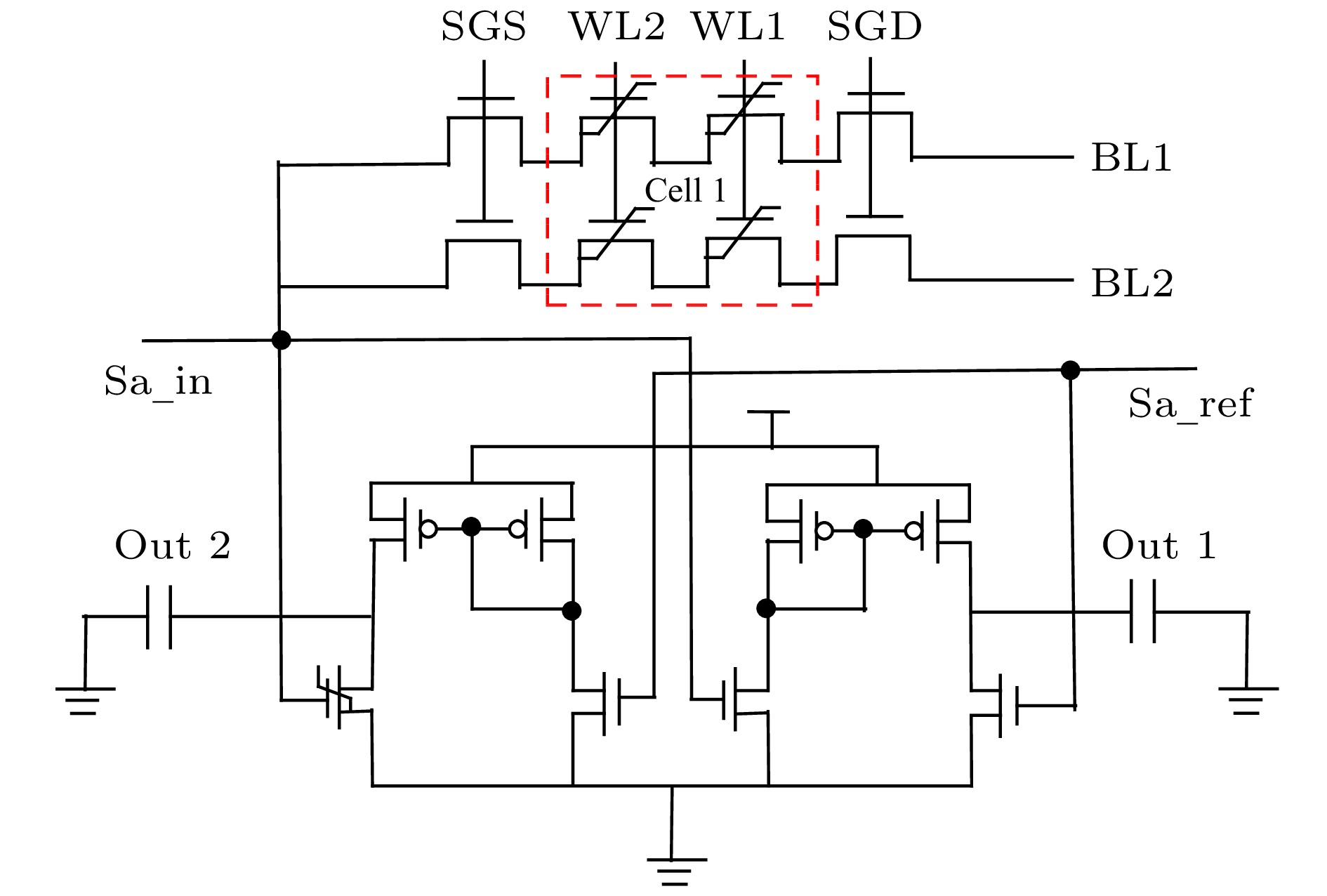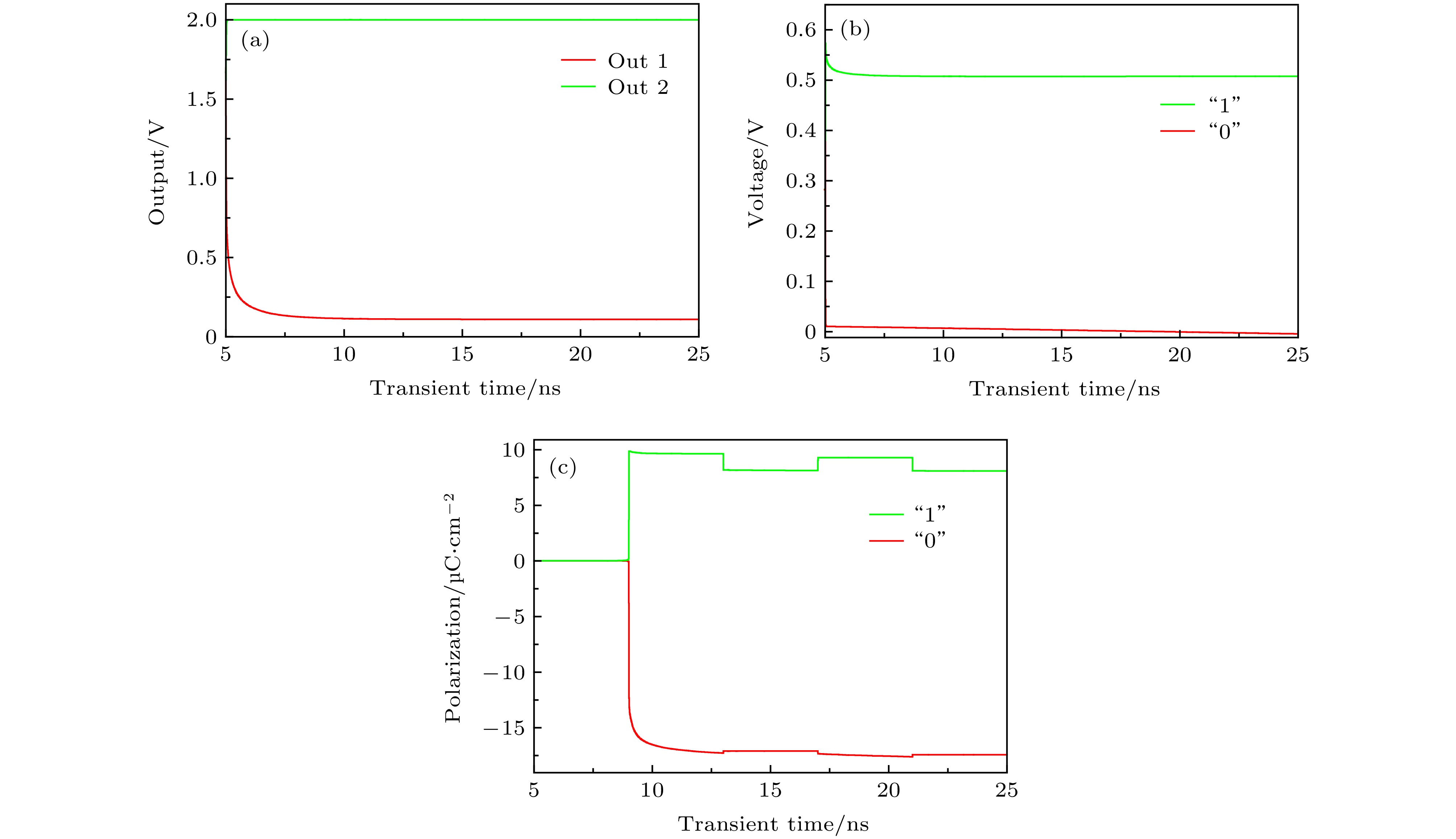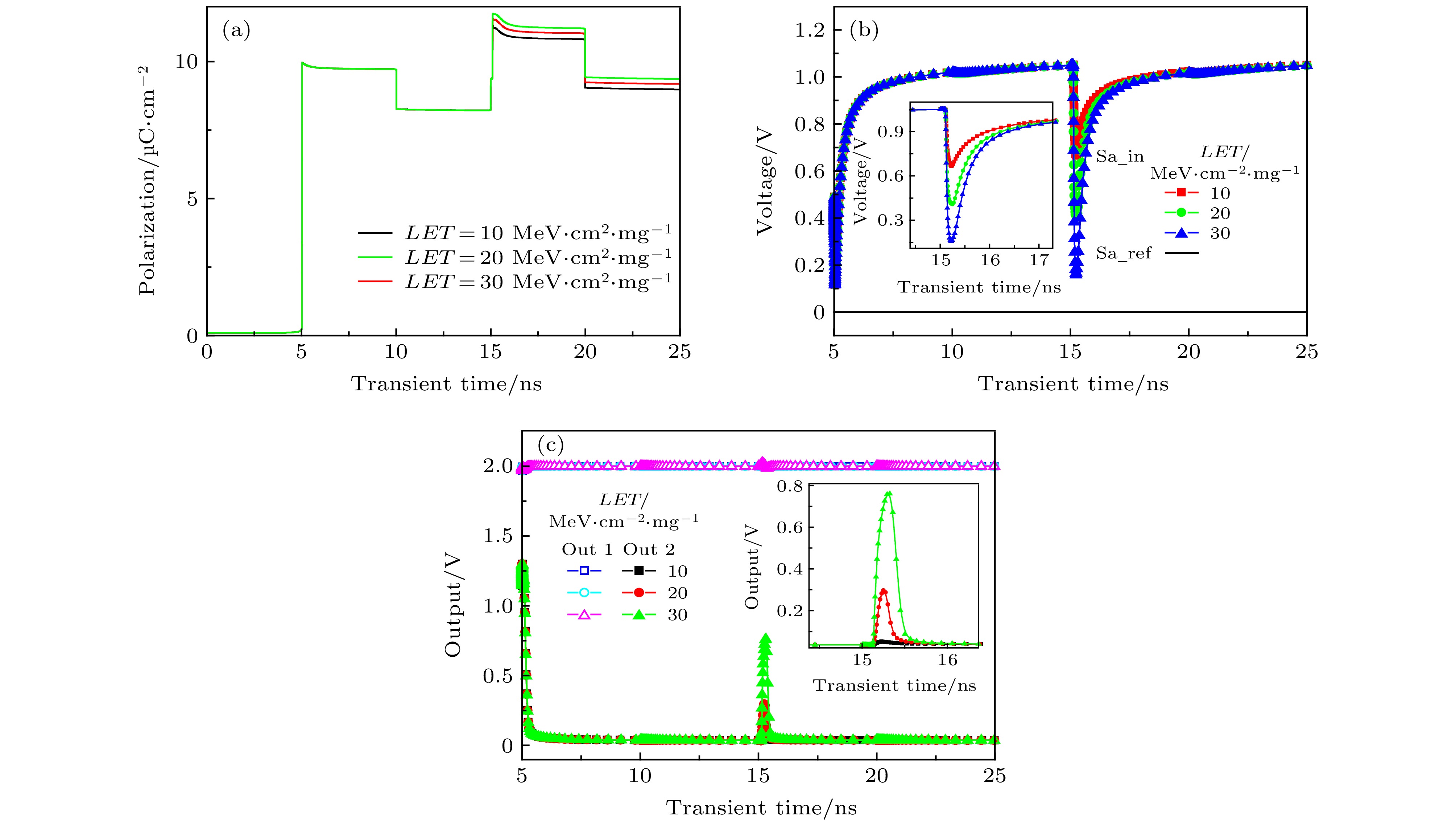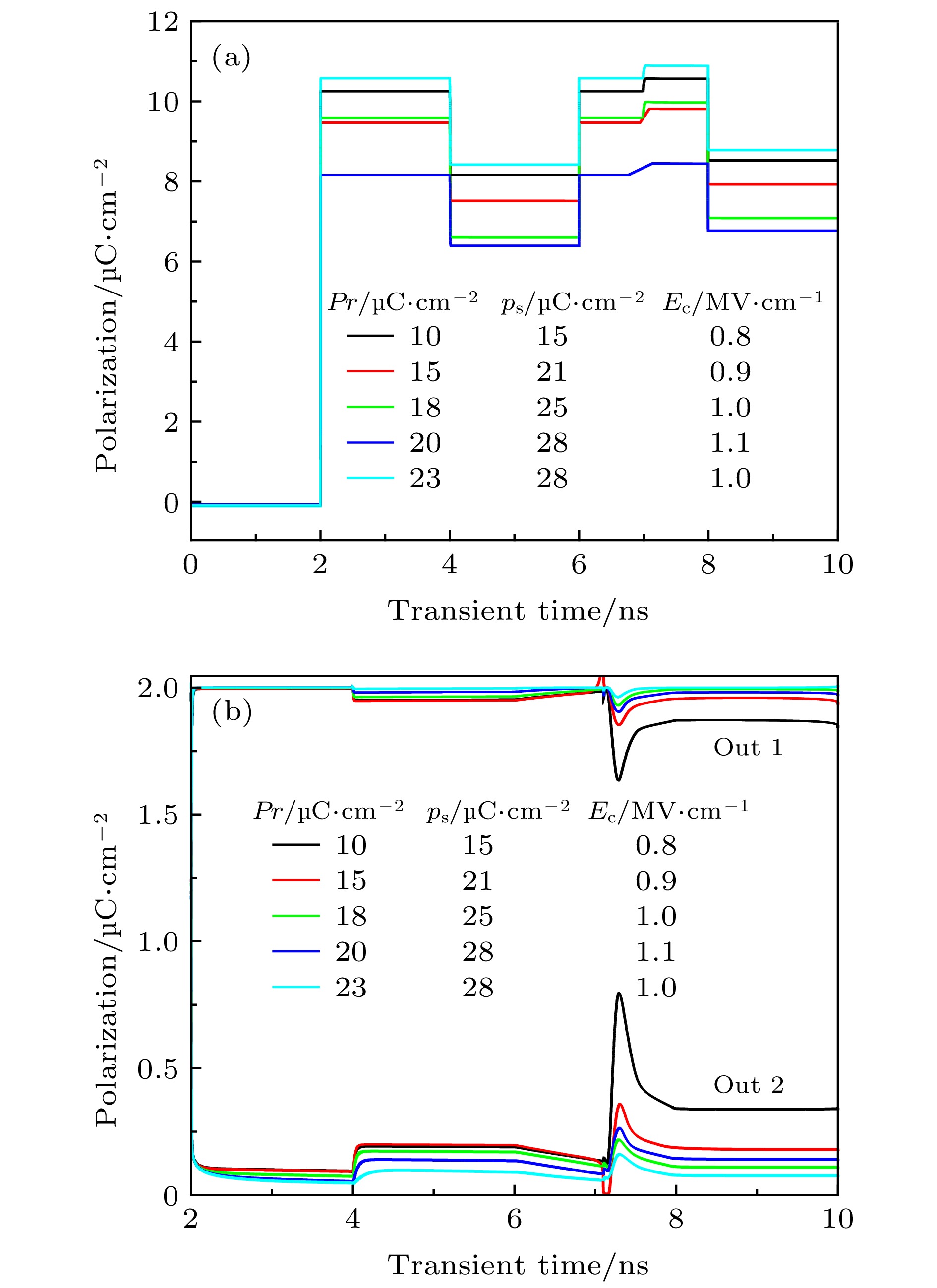-
使用器件-电路仿真方法搭建了氧化铪基铁电场效应晶体管读写电路, 研究了单粒子入射铁电场效应晶体管存储单元和外围灵敏放大器敏感节点后读写数据的变化情况, 分析了读写数据波动的内在机制. 结果表明: 高能粒子入射该读写电路中的铁电存储单元漏极时, 处于“0”状态的存储单元产生的电子空穴对在器件内部堆积, 使得栅极的电场强度和铁电极化增大, 而处于“1”状态的存储单元由于源极的电荷注入作用使得输出的瞬态脉冲电压信号有较大波动; 高能粒子入射放大器灵敏节点时, 产生的收集电流使处于读“0”状态的放大器开启, 导致输出数据波动, 但是其波动时间仅为0.4 ns, 数据没有发生单粒子翻转能正常读出. 两束高能粒子时间间隔0.5 ns先后作用铁电存储单元漏极, 比单束高能粒子产生更大的输出数据信号波动, 读写“1”状态的最终输出电压差变小.Ferroelectric field effect transistor (FeFET) is a promising memory cell for space application. The FeFET can achieve non-destructive reading, and has the advantages of simple structure and high integration. Ferroelectric thin film’s size effect, retention performance and radiation resistance of ferroelectric thin films directly determine the performances of FeFET devices. The HfO2 is widely used as a dielectric in complementary metal oxide semiconductor (CMOS) device and can solve the common integration problems for ferroelectric materials due to its CMOS compatibility. When the HfO2-based FeFETs are applied to aerospace electronics, the effects of various radiation particles need to be considered. The HfO2-based FeFET memory is still in the experimental stage, and there are no products of HfO2-based FeFET chips available from the market, so it is difficult to carry out experimental research on its single particle effect In the case of lacking the finished products of HfO2-based FeFET devices, using the device-hybrid simulation method to study the HfO2-based FeFET single-particle effect is a necessary and feasible content for the research on HfO2-based FeFET single-particle effects. In this paper, the device-circuit simulation method is used to build a read-write circuit of HfO2-based ferroelectric field-effect transistor. The change of read and write data after a single particle is incident on a ferroelectric field effect transistor memory cell and a sensitive node of a peripheral sense amplifier is studied, and the internal mechanism of read and write data fluctuation is analyzed. The results show that when high-energy particles enter into the drain of the ferroelectric memory cell in the read-write circuit, the memory cells in the “0” state generate electron-hole pairs, which accumulate inside the device, causing the gate electric field strength and ferroelectricity to increase, and the memory cell in the “1” state has a large fluctuation in the output transient pulse voltage signal due to the charge injection of the source, indicating that the ferroelectric memory cell has a good performance against particle flipping; when high-energy particles enter into the amplifier’s sensitive node, a collection current is generated, causing the amplifier in the state of reading “0” to turn on, and the output data to fluctuate. Owing to the fluctuation time being only 0.4 ns, the data does not have single-particle flipping energy under normal readout, and the HfO2-based FeFET read-write circuit has excellent resistance to single particles. When two beams of high-energy particles act on the drain of a ferroelectric memory cell successively in a time interval of 0.5 ns, the output data signal fluctuates more than in the case of a single beam of high-energy particles, and the final output voltage difference in the reading and writing “1” state becomes smaller.
[1] Irom F, Nguyen D N, Underwood M L, Virtanen A 2010 IEEE Trans. Nucl. Sci. 57 3329
 Google Scholar
Google Scholar
[2] Weller R A, Mendenhall M H, Reed R A, Schrimpf R D 2010 Trans. Nucl. Sci. 57 1726
 Google Scholar
Google Scholar
[3] 付承菊, 郭冬云 2006 微纳电子技术 9 14
Fu C J, Guo D Y 2006 Micro-nano Technology 9 14
[4] Mikolajick T, Slesazeck S, Park M H, Schroeder U 2018 MRS Bull. 43 340
 Google Scholar
Google Scholar
[5] Li H, Hu M, Li C, Duan S 2014 IEEE Computer Society Annual Symposium on VLSI (ISVLSI) Tampa, FL, USA, July 9−11, 2014 p65
[6] 何伟 2014 硕士学位论文 (成都: 电子科技大学)
He W 2007 Ph. D. Dissertation (Chendu: University of Electronic Science and Technology) (in Chinese)
[7] Sharma D K, Khosla R, Sharma S K 2015 Solid-State Electron. 42 111
 Google Scholar
Google Scholar
[8] Wang P, Wang Y, Ye L, Wu M, Xie R, Wang X, Hu W 2018 Small 14 1800492
 Google Scholar
Google Scholar
[9] Wang J, Fang H, Wang X, Chen X, Lu W, Hu W 2017 Small 13 1700894
 Google Scholar
Google Scholar
[10] Wang X, Wang P, Wang J, Hu, W., Zhou, X, Guo N, Chu J 2015 Adv. Mater. 27 6575
 Google Scholar
Google Scholar
[11] Tu L, Cao R, Wang X, Chen Y, Wu S, Wang F, Chu J 2020 Nat. Commun. 11 1
 Google Scholar
Google Scholar
[12] Tu L, Wang X, Wang J, Meng X, Chu J 2018 Adv. Electron. Mater. 4 1800231
 Google Scholar
Google Scholar
[13] 唐明华 2007 博士学位论文 (湘潭: 湘潭大学)
Tang M H 2007 Ph. D. Dissertation (Xiangtan: Xiangtan University) (in Chinese)
[14] Amusan O A, Massengill L W, Baze M P 2007 IEEE Trans. Nucl. Sci. 54 2584
 Google Scholar
Google Scholar
[15] Coic Y M, Musseau O, Leray J L 1994 IEEE Trans. Nucl. Sci. 41 495
 Google Scholar
Google Scholar
[16] Li X, Lai L 2018 IEEE Computer Society Annual Symposium on VLSI (ISVLSI) Hong Kong, China, July 8−11, 2018 p750
[17] Ni K, Li X Q, Jeffrey A S, Matthew J, Suman D 2018 IEEE Electron Device Lett. 39 1656
 Google Scholar
Google Scholar
[18] Lee D, Yoon A, Jang S Y, Yoon J G, Chung J S, Kim M, Scott J F, Noh T W 2011 Phys. Rev. Lett. 107 057602
 Google Scholar
Google Scholar
[19] Takahashi M, Zhang W, Sakai S 2018 IEEE International Memory Workshop (IMW) Kyoto, Japan, May 13−16, 2018 p1
[20] Gong N B, Ma T P 2016 IEEE Electron Device Lett. 37 1123
 Google Scholar
Google Scholar
[21] Sharma A, Roy K 2018 IEEE Electron Device Lett. 39 359
 Google Scholar
Google Scholar
[22] 刘巧灵 2018 硕士学位论文 (湘潭: 湘潭大学)
Liu Q L 2018 Ph. D. Dissertation (Xiangtan: Xiangtan University) (in Chinese)
[23] 丁曼 2019 强激光与粒子束 31 066001
 Google Scholar
Google Scholar
Ding M 2019 Strong Laser and Particle Beam 31 066001
 Google Scholar
Google Scholar
[24] Bosser A L, Gupta V, Javanainen A 2018 IEEE Trans. Nucl. Sci. 65 1708
 Google Scholar
Google Scholar
[25] Yan S A, Tang M H, Zhao W, Guo H X, Zhang W L, Xu X Y, Wang X D, Ding H, Chen J W, Li Z, Zhou Y C 2014 Chin. Phys. B 23 046104
 Google Scholar
Google Scholar
[26] Synopsys Inc. https://www.synopsys.com/silicon/tcad.html [2019-11-10]
[27] Nanoscale Integration and Modeling Group http://ptm.asu.edu/ [2019-11-10]
[28] Miller S L, Mcwhorter P J 1992 J. Appl. Phys. 72 5999
 Google Scholar
Google Scholar
-
图 6 单粒子入射读写“0”铁电存储单元cell 1漏极的瞬态效应 (a) cell 1漏极电流脉冲变化; (b) cell 1输出信号变化; (c) cell 1极化强度变化; (d)灵敏放大器输出信号变化
Fig. 6. Transient effects of single-particle incident read and write “0” ferroelectric storage tube drain: (a) Change of drain current pulse; (b) change of cell 1 output signal; (c) change of cell 1 polarization intensity; (d) change of sense amplifier output signal.
图 7 单粒子入射读写“1”铁电存储单元cell 1漏极的瞬态效应 (a) cell 1极化强度变化; (b) cell 1输出信号变化; (c)灵敏放大器输出信号变化
Fig. 7. Transient effects of single-particle incident read and write “1” ferroelectric storage tube drain: (a) Change of cell 1 polarization intensity; (b) change of cell 1 output signal; (c) change of sense amplifier output signal.
图 10 单粒子作用于不同剩余极化和矫顽场的HZO铁电薄膜下的铁电存储单元cell 1的信号变化 (a) 铁电存储单元的极化强度变化; (b)灵敏放大器输出信号变化
Fig. 10. Signal change of ferroelectric memory cell cell 1 under single-particle HZO ferroelectric thin film with different remanent polarization and coercive field: (a) Change of ferroelectric transistor polarization intensity; (b) change of sense amplifier output signal.
图 11 两束单粒子入射读写“1”铁电存储单元cell 1漏极的瞬态效应 (a) cell 1漏极电流脉冲变化; (b) cell 1极化强度变化; (c)灵敏放大器输出信号变化
Fig. 11. Transient effects of two single-particle incident read and write “1” ferroelectric storage tube drain: (a) Change of drain current pulse; (b) change of cell 1 polarization intensity; (c) change of sense amplifier output signal.
表 1 HfO2基FeFET工艺参数
Table 1. Process parameters of HfO2-FeFET.
参数 数值 多晶硅厚度/nm 20 栅氧层厚度/nm 1 铁电层厚度/nm 10 沟道长度/nm 45 N型衬底浓度/cm–3 1 × 1016 N阱浓度/cm–3 5 × 1016 源/漏浓度/cm–3 2 × 1020 阈值电压掺杂浓度/cm–3 5 × 1017 饱和极化值Ps/μC·cm–2 28 剩余极化值Pr/μC·cm–2 23 矫顽场强度Ec/MV·cm–1 1 介电常数Eps 22 表 2 输出端Out 1和Out 2之间的电位差变化
Table 2. Voltage difference change between Out 1 and Out 2.
LET值/MeV·cm2·mg–1 0 10 20 30 120 150 180 电压差/V 1.9 1.85 1.7 1.2 1 0.95 0.9 -
[1] Irom F, Nguyen D N, Underwood M L, Virtanen A 2010 IEEE Trans. Nucl. Sci. 57 3329
 Google Scholar
Google Scholar
[2] Weller R A, Mendenhall M H, Reed R A, Schrimpf R D 2010 Trans. Nucl. Sci. 57 1726
 Google Scholar
Google Scholar
[3] 付承菊, 郭冬云 2006 微纳电子技术 9 14
Fu C J, Guo D Y 2006 Micro-nano Technology 9 14
[4] Mikolajick T, Slesazeck S, Park M H, Schroeder U 2018 MRS Bull. 43 340
 Google Scholar
Google Scholar
[5] Li H, Hu M, Li C, Duan S 2014 IEEE Computer Society Annual Symposium on VLSI (ISVLSI) Tampa, FL, USA, July 9−11, 2014 p65
[6] 何伟 2014 硕士学位论文 (成都: 电子科技大学)
He W 2007 Ph. D. Dissertation (Chendu: University of Electronic Science and Technology) (in Chinese)
[7] Sharma D K, Khosla R, Sharma S K 2015 Solid-State Electron. 42 111
 Google Scholar
Google Scholar
[8] Wang P, Wang Y, Ye L, Wu M, Xie R, Wang X, Hu W 2018 Small 14 1800492
 Google Scholar
Google Scholar
[9] Wang J, Fang H, Wang X, Chen X, Lu W, Hu W 2017 Small 13 1700894
 Google Scholar
Google Scholar
[10] Wang X, Wang P, Wang J, Hu, W., Zhou, X, Guo N, Chu J 2015 Adv. Mater. 27 6575
 Google Scholar
Google Scholar
[11] Tu L, Cao R, Wang X, Chen Y, Wu S, Wang F, Chu J 2020 Nat. Commun. 11 1
 Google Scholar
Google Scholar
[12] Tu L, Wang X, Wang J, Meng X, Chu J 2018 Adv. Electron. Mater. 4 1800231
 Google Scholar
Google Scholar
[13] 唐明华 2007 博士学位论文 (湘潭: 湘潭大学)
Tang M H 2007 Ph. D. Dissertation (Xiangtan: Xiangtan University) (in Chinese)
[14] Amusan O A, Massengill L W, Baze M P 2007 IEEE Trans. Nucl. Sci. 54 2584
 Google Scholar
Google Scholar
[15] Coic Y M, Musseau O, Leray J L 1994 IEEE Trans. Nucl. Sci. 41 495
 Google Scholar
Google Scholar
[16] Li X, Lai L 2018 IEEE Computer Society Annual Symposium on VLSI (ISVLSI) Hong Kong, China, July 8−11, 2018 p750
[17] Ni K, Li X Q, Jeffrey A S, Matthew J, Suman D 2018 IEEE Electron Device Lett. 39 1656
 Google Scholar
Google Scholar
[18] Lee D, Yoon A, Jang S Y, Yoon J G, Chung J S, Kim M, Scott J F, Noh T W 2011 Phys. Rev. Lett. 107 057602
 Google Scholar
Google Scholar
[19] Takahashi M, Zhang W, Sakai S 2018 IEEE International Memory Workshop (IMW) Kyoto, Japan, May 13−16, 2018 p1
[20] Gong N B, Ma T P 2016 IEEE Electron Device Lett. 37 1123
 Google Scholar
Google Scholar
[21] Sharma A, Roy K 2018 IEEE Electron Device Lett. 39 359
 Google Scholar
Google Scholar
[22] 刘巧灵 2018 硕士学位论文 (湘潭: 湘潭大学)
Liu Q L 2018 Ph. D. Dissertation (Xiangtan: Xiangtan University) (in Chinese)
[23] 丁曼 2019 强激光与粒子束 31 066001
 Google Scholar
Google Scholar
Ding M 2019 Strong Laser and Particle Beam 31 066001
 Google Scholar
Google Scholar
[24] Bosser A L, Gupta V, Javanainen A 2018 IEEE Trans. Nucl. Sci. 65 1708
 Google Scholar
Google Scholar
[25] Yan S A, Tang M H, Zhao W, Guo H X, Zhang W L, Xu X Y, Wang X D, Ding H, Chen J W, Li Z, Zhou Y C 2014 Chin. Phys. B 23 046104
 Google Scholar
Google Scholar
[26] Synopsys Inc. https://www.synopsys.com/silicon/tcad.html [2019-11-10]
[27] Nanoscale Integration and Modeling Group http://ptm.asu.edu/ [2019-11-10]
[28] Miller S L, Mcwhorter P J 1992 J. Appl. Phys. 72 5999
 Google Scholar
Google Scholar
计量
- 文章访问数: 16188
- PDF下载量: 183
- 被引次数: 0














 下载:
下载:











